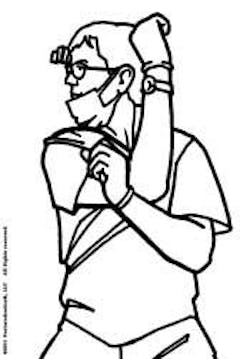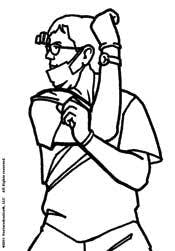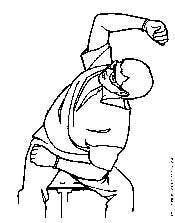It's a S-T-R-E-T-C-H
For more on this topic, go to www.dentaleconomics.com and search using the following key words: musculoskeletal health, microtrauma in dentistry, stretching exercises, chairside microbreaks, career longevity.
As the practice of dentistry changes, dentists should be cognizant of how these changes impact their musculoskeletal health. Studies suggest that the increase in dental operator pain since the 1960s may be because of longer procedures and fewer breaks. This is due in part to the use of four-handed dentistry techniques.
Prolonged, static postures are the greatest culprit in the demise of dentists' musculoskeletal health. Sustained muscle contractions can cause painful muscle ischemia and the development of "tender spots," or trigger points in muscles. These muscles can become ischemic and vertebral joints can become deprived of movement, which is essential to nourishment of the disc.
Complicating the problem are unbalanced operating postures to visualize the working surface, which are usually in one direction. Over time, this can cause muscle imbalances (tightness in one group of muscles and weakness in an opposing group), and lead to a plethora of musculoskeletal pain syndromes. While the body is designed to tolerate brief awkward postures, it is not designed to hold these unbalanced postures for several minutes or more at a time throughout the day.
Chairside stretching
Research reveals that taking frequent breaks to move around are integral to an effective injury prevention program and pain control in dentistry.
A regular routine of chairside stretching may prevent a myriad of neuromuscular dysfunctions that can lead to painful musculoskeletal disorders or early retirement. It's the only strategy I'm aware of that addresses every microtrauma that results from prolonged, static postures in dentistry. The time commitment is minimal and the benefits are numerous:
- Increases blood flow to muscles
- Increases production of joint synovial fluid
- Reduces formation of trigger points
- Maintains normal joint range of motion
- Increases nutrient supply to vertebral discs
- Creates a relaxation response in the central nervous system
- Warms up the muscle before beginning work
- Identifies tight structures that may be predisposed to injury
An effective chairside stretching program should be developed specifically for dentists and target those muscles and structures that are prone to ischemia and tightness. For example, I developed the "un-twister" stretch (pictured above) based on a Swedish dental study that revealed a limited range of motion among dentists, and a Japanese dental study that demonstrated repeated asymmetrical posturing.
For optimal benefit, it's a good idea to observe and refresh proper stretching techniques either in an educational environment or via video. It is also helpful to hang stretching wall charts in the operatory or staff lounge. (Dental chairside stretching DVDs and laminated stretching wall charts are available at www.posture dontics.com.)
Regular stretching, both chairside and out of the operatory, is an important lifestyle adjustment that can put one on the path to a healthier career.
How to stretch safely
To avoid injury during stretching, follow these tips:
- Assume the starting position for the stretch
- Breathe in deeply
- Exhale as you slowly increase the intensity of the stretch up to a point of mild tension or discomfort
- Hold the stretch for two to four breathing cycles (10 to 20 seconds)
- Slowly release the stretch — come back to neutral position. Repeat the stretch, if time allows.
- Try the stretch in both directions, and determine which side is tightest. Perform the directional stretch primarily toward the tightest side throughout the workday, and place stretching charts where you can easily reference them while chairside. At home and on weekends, perform stretches in both directions.
- Never stretch in a painful range. If stretching increases your pain, stop immediately.
Stretching during microbreaks
The body is constantly repairing microtrauma that occurs during the workday. However, if stretch breaks are too far apart, the rate of damage will exceed the rate of repair, ultimately resulting in breakdown of tissue. A rest break for more than 50 seconds does not improve the force-generation capacity (strength) of the muscles.
To optimize the strength capacity of the worker and minimize the risk of muscle strain, a schedule of brief, yet frequent rest periods is more beneficial than lengthy infrequent rest periods. Therefore, chairside stretches should be performed every 30 to 60 minutes throughout the day and able to be performed easily at chairside while wearing gloves.
Worried about productivity? A study on the efficacy of microbreaks during the workday found that with regularly scheduled microbreaks, workers had less discomfort, and that the addition of 30-second microbreaks showed no detrimental effect on worker productivity. Authors have pointed to the efficacy of using micropauses and stretching during dental procedures. Take 10- to 20-second microbreaks throughout the workday to stretch, while waiting for anesthetic to take effect, between patients, during a missed appointment, or during a recall exam. Use your imagination! Remember to stretch at home and on weekends.
Now is the perfect time to take charge of your musculoskeletal health and ensure career longevity. Don't wait for a painful episode to start implementing strategies that will move you closer to a longer, more fulfilling career. Taking short, frequent breaks and reversing your operator position with chairside stretching are essential keys to attaining optimal musculoskeletal health. As someone once said: "Muscles are like leather shoes — the more you use them, the better they feel."
References available upon request.
Bethany Valachi, PT, MS, CEAS, is author of the "Chairside Stretching and Trigger Point Therapy for Dental Professionals" DVD. She is a physical therapist, dental ergonomic consultant, and author of the new book, "Practice Dentistry Pain-free: Evidence-based Strategies to Prevent Pain and Extend your Career." She lectures internationally at dental meetings, state associations, and dental study clubs. Her company, Posturedontics®, provides research-based education and evaluates dental ergonomic products. For free articles, product and seminar information, visit www.posturedontics.com or call (503) 291-5121.




